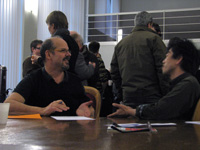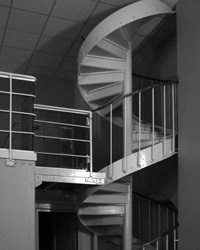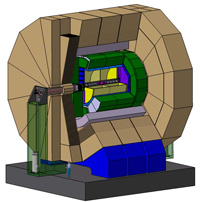 |
 |
|||||||||||||
|
|||||||||||||
|
|||||||||||||
|
Some 100 members of the International Large Detector (ILD) group gathered from 27 to 30 January 2010 in Paris, France, deep in the academic Latin Quarter area. This fourth ILD workshop was the first dedicated ILD meeting after the concept was validated in 2009 by the research directorate.
The goal of the workshop was to discuss a plan how by the end of 2012 the ILD concept can present a well understood detector design, with technical solutions which are "ready". Guided by an overall roadmap for the detector community proposed by the Research Director, Sakue Yamada, this next major step will take into account all sub-detector systems, but also the beam delivery system design, the push-pull hall design and concentrate particularly on all aspects of the detector integration. Another related topic was to identify the necessary R&D and the available resources, and take another hard look at the overall optimisation of the concept. Finally, their major issue was to converge on a procedure to evaluate the readiness of technical solutions. The results of this will be presented in a detector baseline document by the end of 2012. Who will declare that a technology could be part of the baseline? What are the differences between baseline and alternative technology choices? These were some of the questions raised by Ties Behnke, ILD contact person for Europe with Henri Videau, during the 'Discussion on evaluation procedures' session. Within each R&D collaboration, contact persons are in charge of facilitating communication between their sub-detector and the ILD group. “These people have to be well integrated in both R&D and concept groups,” said Behnke, “so that we make sure that they provide relevant feedback and a good interface.” As one of these contacts, Felix Sefkow, spokesperson of the CALICE (Calorimeter for the linear collider experiment) Collaboration presented the point of view of his collaboration. Sefkow agreed on the importance of close contact between the two communities, but also stressed that the R&D collaborations cater often to more than one concept group. He invited a close exchange of ideas between the concept groups and the R&D collaborations. Attendees stressed that the ILD concept group and the R&D collaborations have to decide together whether a technology is mature or not. “We won't decide now which option is 'alternative' or 'baseline', since we want to push each option to its optimum before comparing them,” said Behnke. “The choice which technology will be considered baseline will be done as late as possible, probably during the first half of 2012. However the criteria for this decision need to be defined now.” Alternative choices — defined as less advanced choices which could become feasible with more resources or time, will be seriously considered and included in the 2012 report. To make these choices, one of the difficulties is to make sure that the communication between R&D groups and the ILD concept are well established. “Who is responsible for cables? Or for the constraints of one detector on another one?” asks Henri Videau, “We need to make sure that every aspect will be considered. Our detector will not be a collection of sub-detectors, but a well defined one.” It was also stressed at the meeting that the R&D does not stop with these decisions, but will continue, possibly even changing some of the decisions at a later stage. The plenary discussions were prepared by a series of pre-meetings the day before and were introduced by a presentation of each sub-detector group which reviewed their last milestones and open questions in connection to ILD. Sakue Yamada stressed in his introductory talk that it was a chance for the discussion that people from all areas of the detector – R&D collaborations, optimisation group, machine detector interface, costing, and also CLIC/ILC joint group – were present in Paris. An important aspect of the ILD work is to demonstrate that the ILD concept can deliver the physics results expected. To show this, significant simulation work is needed. In addition to the technological baseline a simulation baseline therefore needs to be defined, and needs to be defined much earlier if a large-scale production is supposed to happen. The simulation baseline needs to be frozen at the latest in the fall of 2011, ideally even earlier. The conclusions of the meeting will be presented to the research directorate and the ILC steering bodies over the next few months. The concept group will meet the next time at the ILC/LCWS2010 meeting in Beijing in March to refine their plans. At that meeting the international detector advisory group, IDAG, will review the progress of the group for the first time, and discuss with ILD the next steps. Paris was seen as a very successful meeting by its participants. “We really feel that we made a lot of progress and understand now much better the next steps,” commented Yasuhiro Sugimoto, one of the Asian contact people for ILD, after the meeting. -- Perrine Royole-Degieux |
|||||||||||||
| © International Linear Collider |


